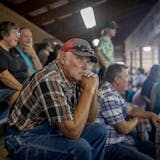You won't find it anywhere on his résumé, but Tom Kanavy has been an NFL "get-back" coach since 1995.
For six days a week during an NFL season, he's the head strength and conditioning coach for the Vikings. But for 60 minutes — or 75 in some cases — he's the head "get-back" coach whose sole purpose is to constantly tell players, coaches and anyone else to "get back" when they start creeping onto the white out-of-bounds sideline stripe.
"Basically, it's not that difficult a job," Kanavy said. "It's a consistent duty. You do it all game, every game. But it doesn't take much skill or talent. You just need a loud voice and a big mouth."
Steelers coach Mike Tomlin might disagree after being fined $100,000 this week for interfering with Baltimore's Jacoby Jones on a kickoff return during a 22-20 loss to the Ravens on Thanksgiving. Pittsburgh also is in danger of losing a draft pick "because the conduct affected a play on the field," the NFL said. Tomlin also should have been flagged with a 15-yard penalty but wasn't.
Tomlin said he simply lost track of where he was.
"It happens," Vikings coach Leslie Frazier said. "You get caught up in the game and you do need someone reminding you to get back. Your get-back coach has a stressful job. And, no question, there will be more scrutiny this week and going forward."
As the Vikings head "get-back" coach, Kanavy positions himself 10 to 30 yards downfield from the line of scrimmage. That's where players and officials on the field run the highest risk of injury from colliding with sideline players who drift into the restricted area.
Martin Streight, one of the team's assistant strength and conditioning coaches, is the assistant "get-back" coach. He monitors the sideline at the line of scrimmage. When an extra pair of eyes is needed, Aaron McLaurin, another assistant strength and conditioning coach, helps out.


